-
Car Reviews
- All reviews
- Midsize SUVs
- Small cars
- Utes
- Small SUVs
- Large SUVs
- Large cars
- Sports SUVs
- Sports cars
- Vans
Latest reviews
- Car News
-
Car Comparisons
Latest comparisons
- Chasing Deals
Two years after the current Hyundai Santa Fe arrived in Australia, the three-row crossover has had a major makeover – and the changes make the 2021 Santa Fe one of the best family SUVs on the market.
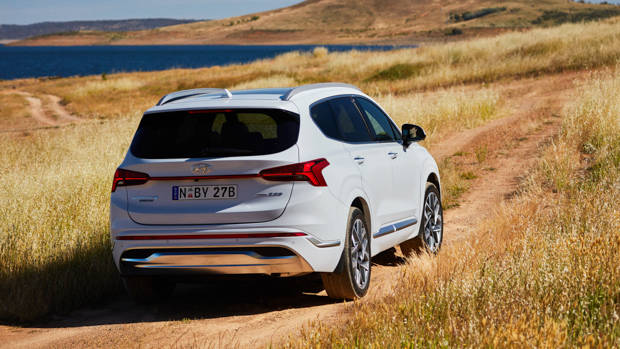
The arrival of the new Hyundai Palisade large SUV in Australia might be the best thing that’s ever happened to the slightly smaller Santa Fe.
Freed from needing to be an SUV for all people, the Santa Fe now gets to focus on its more sporty edge – or at least that’s how Hyundai’s Australian chassis experts put it.
Returning for 2021 with a considerable visual upgrade, the Santa Fe now competes squarely with more compact seven-seaters like the Skoda Kodiaq and Mazda CX-8, while the Palisade, reviewed here, caters to buyers who need something bigger with a properly commodious third row.
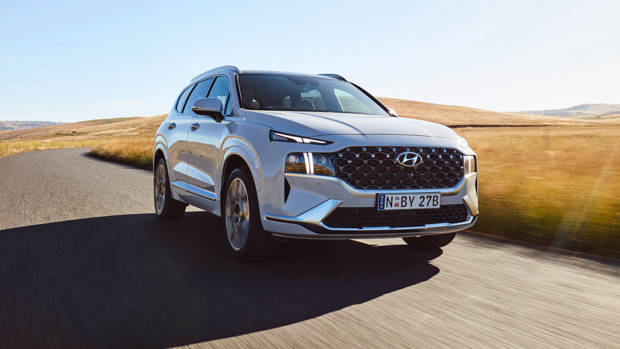
The scale of the changes to the Santa Fe are unusual for a vehicle that is, relatively speaking, quite new. While the chassis underneath this popular SUV is largely unchanged, much of the bodywork outside is updated, and there are considerable changes inside, too. A set of more efficient engines leads the alterations under the skin.
Starting from $44,700, every new Santa Fe grade benefits from a more cohesive look outside, as usual, the best is reserved for the top-shelf Santa Fe Highlander variant ($61,700 petrol, $65,200 diesel) that is particularly popular with Australian buyers.
Wearing full body-coloured cladding outside, meaner and larger 20-inch wheels, and sporting a cabin lined in nappa leather upholstery, the 2021 Santa Fe Highlander is genuinely knocking on the door of luxury SUVs.
This update to the Santa Fe is best considered a heavy facelift inside and out, but there are some noteworthy engineering changes as well – starting under the bonnet.
First up is an almost-new diesel engine. While the 2.2-litre ‘Smartstream’ four-cylinder turbo is a development of the older R-series diesel used until this point, the engine is now much lighter thanks to a switch to an aluminium block.
Producing 148kW of power and 440Nm of torque, the new diesel doesn’t really offer more power or torque than the old unit – which didn’t feel slow. Instead, the changes flow in the fuel economy department, where the 2021 Santa Fe is noticeably more frugal.
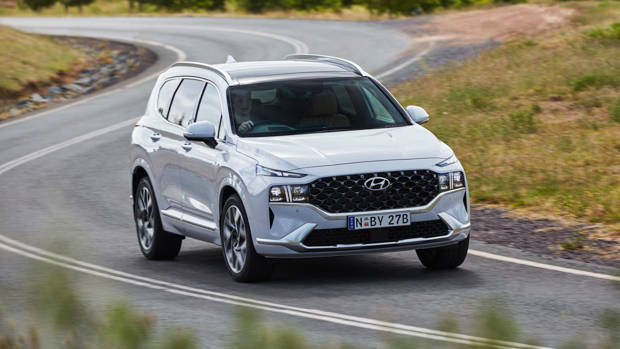
On paper, the diesel now drinks 6.1L/100km (down from an official rating of 7.5L/100km), and our country road-biased launch drive easily turned up figures in the mid-sixes. Diesel engines in large SUVs are still a formula that makes sense in a country like Australia with our ultra-long distances.
The diesel continues to be the Santa Fe’s only all-wheel-drive powertrain. The gearbox is a new eight-speed wet dual-clutch automatic pinched from the forthcoming i30 N DCT, with the aggression naturally toned down.
The oil-submerged unit is a slick-shifting thing that is impressively refined, though some starts from a standstill resulting in slight but noticeable slurring that you don’t find in a torque converter.
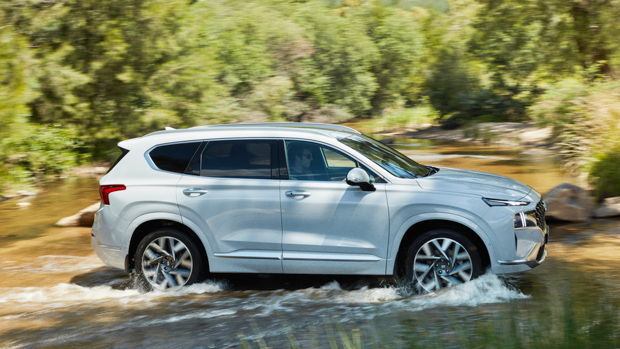
The alternative powertrain is an update to the 3.5-litre naturally aspirated petrol V6 engine that sees outputs tick slightly down to 200kW of power and 334Nm of torque. Also branded as a Smartstream unit, the petrol’s economy improvement of 0.1L/100km (to 10.5L/100km) is much more modest. The petrol V6 doesn’t arrive for another month, so we haven’t driven it yet.
In mid-2021, a petrol-electric hybrid powertrain will be added to the Santa Fe lineup, combining a 1.6-litre turbo petrol four-cylinder with a small motor and battery, producing 169kW of power. AWD will be standard.
So our initial impressions are only of the diesel, which continues to be a pretty muscular, torquey engine that is also reasonably quiet and refined. It’s not as punchy as the Mazda CX-8’s twin-turbo diesel – but the 2.2-litre continues to be a good fit for the Santa Fe.
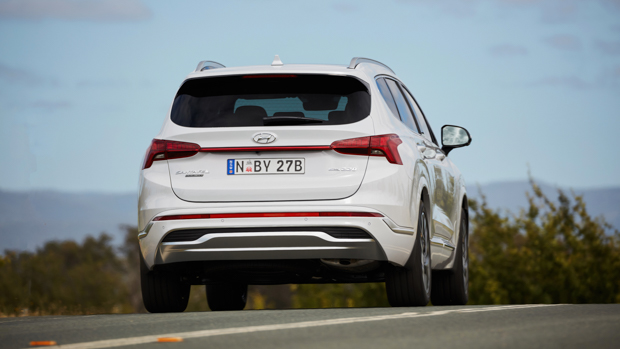
Where we are particularly impressed is in how the updated Santa Fe’s chassis tune has resolved some lingering complaints about ride quality from the pre-facelift version of this car.
When the fourth-generation Santa Fe launched in 2018, we praised its high-speed body control but criticised the stubborn, fussy urban ride quality that was apparently the tradeoff for the impressive country road handling.
It is clear that the ride-handling compromise has been massaged here, with the Santa Fe Highlander grade exhibiting a more calm and compliant ride across a loop around suburban Sydney that included plenty of sub-par pavement.
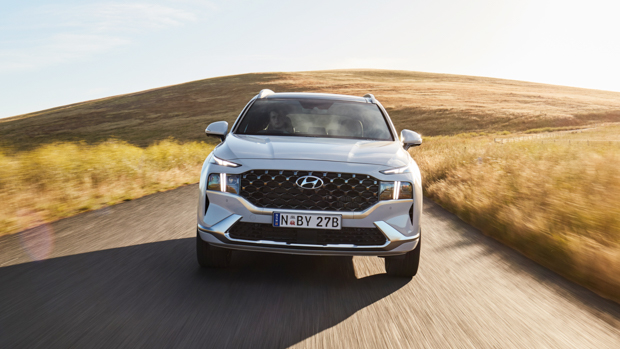
Despite that concession to urban comfort, the Santa Fe’s exceptional country road driving manners have survived intact – meaning the balance now chases the benchmark Skoda Kodiaq for appropriateness across various driving situations.
While the 2021 Santa Fe now runs on a global suspension tune, Hyundai Australia still locally evaluates and tests vehicles before signing off that the dynamics are up to the job of our challenging local roads.
Hustle the Santa Fe quickly along a country road and it still impresses with enthusiastic turn-in and easy, predictable handling toward the SUV’s surprisingly high limits. Its well-adjusted stability control tune still operates intuitively on gravel roads. A standard full-size spare gives confidence on the rough stuff, too.

Both the updated diesel and petrol engines now support a 2,500kg towing capacity for the Santa Fe, and an increased tow ball down weight of 200kg – up from 100kg. As a result, the previous heavy duty rear suspension accessory option has been discontinued.
On the safety front, all Santa Fe variants have six airbags. There’s forward autonomous emergency braking (AEB) with junction AEB, as well as blind spot monitoring and rear cross traffic alert – both with braking intervention. The lane keep assist feature detects lane markings and road edges. Smart cruise control with stop-and-go functionality is joined by automatic high beam, tyre pressure monitoring, and rear parking sensors.
The second-tier Active model adds door exit warning, front parking sensors, and electronic rear child locks to the mix, while the Highlander exclusively picks up very intuitive blind spot view cameras and reversing AEB – a feature that we are disappointed is not standard across the range.
The Santa Fe Highlander’s cabin is very impressive.
Abundantly upholstered with nappa leather on the seats and standard hide on the dashboard, the updated Santa Fe comes across as something of a mini-Genesis GV80.
That’s especially the case if you specify the Highlander with the optional camel beige interior colour that looks more expensive than the standard black trim. The Elite grade (from $54,300) can alternatively be optioned with a cognac-espresso coloured leather which provides a similar effect.
If you’re familiar with the outgoing Santa Fe design, the new ‘bridge’ centre console in the updated car will be the most notable change inside. Dramatically increasing the height of the console between the seats, key controls are now more accessible.
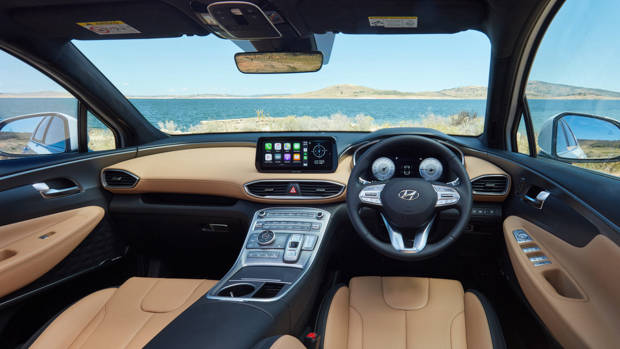
Buyers who dislike the current trend of relegating common functions to touchscreens will like the new Santa Fe, which provides a button for just about anything. The new bridge even incorporates buttons for the automatic gearbox, which adopts a shift-by-wire system rather than the old interior’s conventional shifter. Oddly, the base model keeps the old cabin.
A couple of subtle but very agreeable tech changes caught our eye. The first is the adoption of a larger 10.25-inch touchscreen for the Elite and Highlander grades that is at once wider but also much higher resolution, allowing three discrete panes of information to be presented at once. The second is a shift to a Harman-Kardon premium stereo that sounds crisp.
Unfortunately, the Santa Fe becomes only the latest recent Hyundai release to bizarrely offer convenient, wireless Apple CarPlay and Android Auto on the lower-end eight-inch touchscreen, while the flagship 10.25-inch screen requires a cable for smartphone mirroring: a rare case of getting less while paying (quite a lot) more.

We appreciate the move to a vertical wireless smartphone charger that incorporates a cooling fan and hides your phone’s screen while you’re driving – convenient and safe, and it’s standard range-wide.
The seats themselves are quite comfortable and provide more support than the front pews in the larger Palisade. The plush nappa-upholstered versions in the Highlander are a particular standout, benefitting from power adjustment for the driver and front passenger (ten-way power driver’s adjustment arrives in the Elite).
Be careful or you’ll miss the fact that the Highlander is the only grade that scores heated seats at all – along with cooling up front, heating for the outboard second-row seats, and a heated steering wheel. At least all three rows get air vents in every Santa Fe grade.
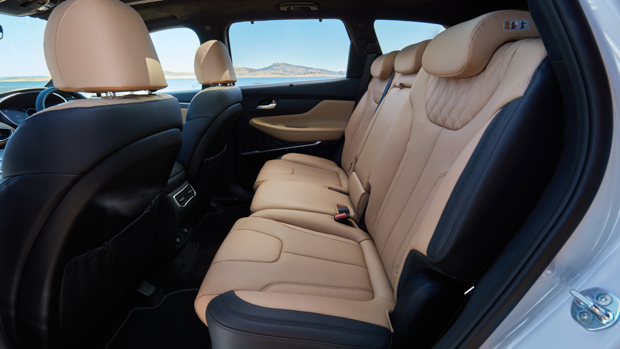
The Highlander adds a bunch of surprise-and-delight features like 64-colour LED ambient cabin lighting, a head-up display, and panoramic sunroof, building on the Elite’s family-friendly rear-door blinds, solar attenuated glass and a third-row USB charger.
Some colleagues commented that leg space in the first row is a bit tight now due to the bigger, wider bridge-type centre console, but it didn’t bother our frame.
The second row bench is relatively supportive as long as your legs aren’t too long, and the fact the pleasant soft-touch materials carry on there is appreciated. It’s certainly not as lush as the optional captain’s chairs on the Palisade, but it’s more than acceptable for adults and kids alike. The second row slides and reclines.
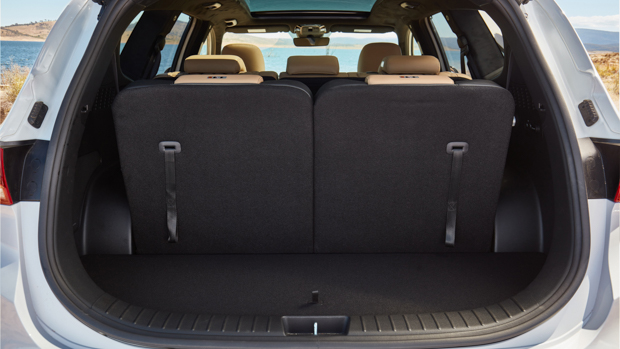
The Santa Fe’s third row, on the other hand, is a kid-only zone. Access is reasonable thanks to the easy kerbside access – the second row tilts and slides with a one-touch button – but legroom and headroom are limited. It’s notable that the Santa Fe’s side curtain airbag only reaches the glass of the third row, not the torso – the Palisade has full coverage.
Around the back, behind a power tailgate, the Santa Fe offers 130 litres of boot space in seven-seat mode – enough to get a few school bags in. In five seat mode, you’ll find between 571 litres and 782 litres depending on how far forward you slide the second row. Finally, in two seat mode, the Santa Fe offers a commodious 1,649 litres of cargo room.
Go for the diesel engine and the Santa Fe’s ongoing running costs will be reasonably affordable.
Hyundai quotes fuel consumption of 6.1L/100km for the new Santa Fe 2.2-litre diesel, but in day-to-day driving we think you’ll manage around 8L/100km without trying too hard. That compares favourably to the incoming V6 petrol, which will use about 12L/100km in the real world.
Hyundai publish lifetime service pricing for their vehicles, and the first five years are capped in price. All new Santa Fe variants have service intervals of 15,000 kilometres or 12 months – whichever comes first.
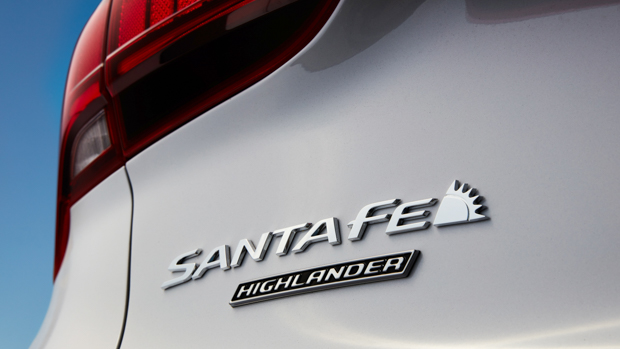
The diesel costs $459 at each service – meaning it will cost $1,377 over three years, or $2,295 over five years. The petrol is marginally (15 per cent) cheaper to service at $399 per visit, explained by that engine’s lack of turbocharging and due to the fact it does not have an AWD system, unlike the diesel.
By contrast, a diesel Mazda CX-8 will cost you $2,655 to service for the same 75,000km over five years as the Santa Fe. On the other hand, the petrol-only Skoda Kodiaq is cheaper to maintain if you purchase an up-front service pack for that car, which costs $1,700 for five years and 75,000km of coverage.
The Hyundai Santa Fe is covered by the brand’s five year, unlimited kilometre warranty.
You’ll also score a year of complimentary roadside assistance, and for every annual logbook service you complete with Hyundai, the brand will throw in an extra year of roadside assist for up to ten years of coverage. The same goes for satellite navigation, which will be updated for free for up to ten years.
The upgrades applied to the 2021 Hyundai Santa Fe add up to create a particularly sweet large SUV package. That’s especially the case for the Highlander diesel AWD, which is expensive, but knocks on the door of far pricier luxury crossovers.
In Highlander guise, the Santa Fe feels genuinely premium. It looks classier than ever outside, and the plush, leather-lined cabin makes driving this SUV more relaxing.
Combine all that with the relaxed, frugal diesel engine and the Santa Fe Highlander becomes a family SUV that is very easy to like.
Key specs (as tested)
About Chasing cars
Chasing Cars reviews are 100% independent.
Because we are powered by Budget Direct Insurance, we don’t receive advertising or sales revenue from car manufacturers.
We’re truly independent – giving you Australia’s best car reviews.
The estimate provided does not take into account your personal circumstances but is intended to give a general indication of the cost of insurance, in order to obtain a complete quote, please visit www.budgetdirect.com.au. Estimate includes 15%^ online discount.
^Conditions Apply
Budget Direct Insurance arranged by Auto & General Services Pty Ltd ACN 003 617 909(AGS) AFSL 241 411, for and on behalf of the insurer, Auto & General Insurance Company Limited(ABN 42 111 586 353, AFSL 285 571).Because we don’t know your financial needs, we can’t advise you if this insurance will suit you. You should consider your needs and the Product Disclosure Statement before making a decision to buy insurance. Terms and conditions apply.
Indicative quote based on assumptions including postcode , 40 year old male with no offences, licence suspensions or claims in the last 5 years, a NCD Rating 1 and no younger drivers listed. White car, driven up to 10,000kms a year, unfinanced, with no modifications, factory options and/or non-standard accessories, private use only and garaged at night.
^Online Discounts Terms & Conditions
1. Discounts apply to the premium paid for a new Budget Direct Gold Comprehensive Car Insurance, Third Party Property Only or Third Party Property, Fire & Theft Insurance policy initiated online on or after 29 March 2017. Discounts do not apply to optional Roadside Assistance.
2. Discounts do not apply to any renewal offer of insurance.
3. Discounts only apply to the insurance portion of the premium. Discounts are applied before government charges, taxes, levies and fees, including instalment processing fees (as applicable). The full extent of discounts may therefore be impacted.
4. We reserve the right to change the offer without notice.